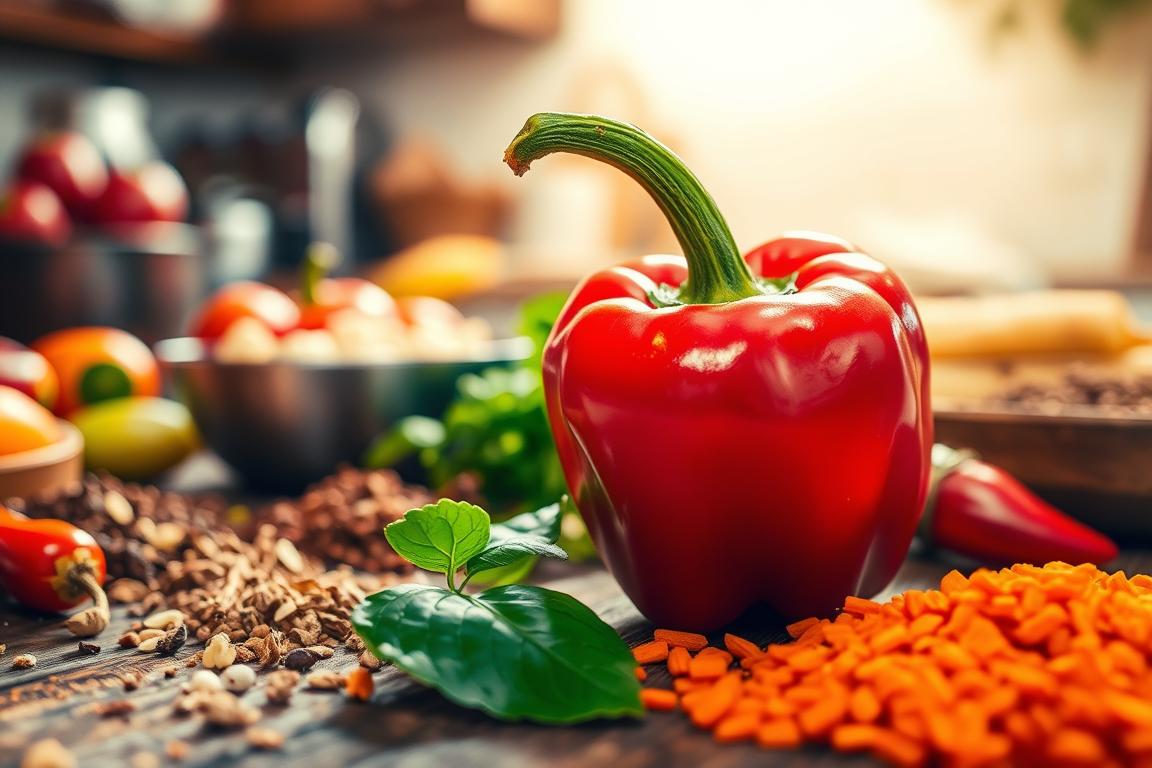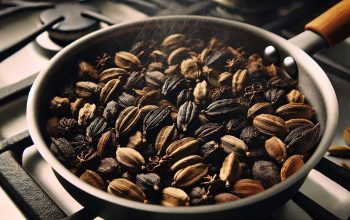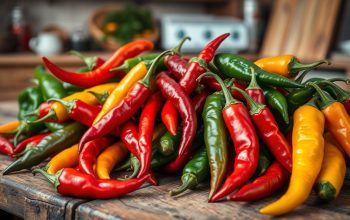Welcome to the world of chili peppers, where flavors and heat come alive. This guide is for anyone starting their culinary journey. It will teach you about the exciting world of chili peppers.
Chili peppers are more than just spice. They open doors to culture, cuisine, and culinary creativity. Each type, from Ancho to Habanero, brings its own taste to your dishes.
This guide covers the basics of chili peppers. We’ll talk about the Scoville scale, heat levels, and health benefits. Whether you love spice or just want to spice up your meals, you’ll learn a lot here.
Key Takeaways
- Discover the diverse world of chili peppers and their unique flavor profiles
- Understand the Scoville scale and how to navigate different heat levels
- Explore the health benefits of incorporating chili into your diet
- Learn safe and effective techniques for handling and cooking with chili peppers
- Gain confidence in exploring regional chili traditions and building your heat tolerance
Understanding the Basics of Chili Heat Levels
Exploring chilies means learning about their heat levels. The Scoville scale measures capsaicin, which makes peppers spicy. It ranges from zero (like bell peppers) to over 2 million (like the Carolina Reaper). This scale helps us understand the different levels of chili heat.
The Scoville Scale Explained
The Scoville scale was created by Wilbur Scoville, an American pharmacist. He found a way to measure chili peppers’ heat in the early 1900s. The scale shows how much capsaicin a pepper has. The more capsaicin, the spicier the pepper.
Different Heat Categories for Beginners
- Mild Chilies (0-2,500 Scoville Heat Units): Sweet bell peppers, banana peppers, and Anaheim chilies are great for beginners.
- Medium Chilies (2,500-5,000 SHU): Poblano, Guajillo, and Ancho peppers offer a gentle heat.
- Hot Chilies (5,000-30,000 SHU): Jalapeños, Serrano, and Cayenne peppers have a stronger heat.
- Extremely Hot Chilies (30,000+ SHU): Habanero, Scotch Bonnet, and Carolina Reaper are for the bravest chili lovers.
How Heat Perception Varies Among People
How people feel chili heat can differ a lot. It depends on genetics, age, gender, and personal tolerance. What’s very spicy for one might not be for another. Learning about the Scoville scale and chili heat levels helps you find your perfect spice level.
Essential Safety Tips for Handling Hot Peppers
Exploring chili peppers requires safety first. Capsaicin, the heat source, can irritate if not handled right. Here are key tips for chili pepper safety:
- Always wear gloves when handling hot peppers. Latex or nitrile gloves prevent capsaicin burns.
- Don’t touch your eyes, nose, or mouth while working with peppers. The oils can cause irritation. Wear eye protection if needed.
- Make sure your workspace has good ventilation. This prevents breathing in chili pepper fumes that can irritate your lungs.
- If you accidentally get capsaicin on your skin, wash it with cold water right away. Don’t rub or scratch, as it can make things worse.
By following these essential safety tips, you can enjoy chili peppers safely. Remember, protective gear and caution are crucial when working with these spicy ingredients.
Getting Started with Mild Chili Varieties
If you’re new to chilies, start with mild ones. These low-heat peppers are easy to begin with. They let you enjoy chili flavors without too much heat.
Poblano Peppers
Poblanos are ideal for beginners. They’re large, heart-shaped, and sweet. With a heat of 1,000 to 2,000 Scoville heat units (SHU), they’re perfect for many dishes.
Anaheim Peppers
Anaheim peppers are mild and great for beginners. They have a spicy, grassy taste. You can use them fresh, roasted, or dried.
Hungarian Wax Peppers
Known as Hungarian wax peppers, they’re mild and bright. With a heat of 500 to 5,000 SHU, they’re perfect for beginners. Their yellow-orange color and sweet taste make them a favorite.
These mild chili pepper varieties are great for starting your chili journey. They help you discover the many flavors chilies offer. By trying these beginner-friendly chilies, you’ll become more confident in your cooking.
The Health Benefits of Adding Chili to Your Diet
Spicy food lovers, rejoice! Recent studies have found many health benefits of eating chili peppers. They can boost your metabolism and reduce inflammation. The compound capsaicin in chili peppers is getting a lot of attention from scientists.
One big benefit of chili peppers is they might help you lose weight. Capsaicin can make your body burn more calories and fat. It also helps you feel full, which is great for keeping a healthy weight.
Chili peppers are also good for your heart. Capsaicin can lower your blood pressure and improve blood flow. This could help prevent heart disease and stroke. Some research even suggests they can lower cholesterol and improve heart health.
If you have chronic pain, chili peppers might help. Capsaicin can relieve pain, making it useful for arthritis, muscle aches, and neuropathic pain. It’s often used in creams and ointments for pain relief.
| Health Benefit | Potential Mechanism |
|---|---|
| Increased Metabolism | Capsaicin stimulates thermogenesis and fat oxidation |
| Improved Cardiovascular Health | Lowers blood pressure and cholesterol levels |
| Pain Relief | Capsaicin has analgesic properties |
While chili peppers offer many health benefits, people with certain conditions should be careful. Those with gastroesophageal reflux disease (GERD) should eat them in moderation. Always talk to a doctor before making big changes to your diet.
Common Chili Pepper Varieties for Beginners
Starting your journey with chili peppers is exciting and a bit overwhelming for beginners. This guide will help you explore the world of chili pepper types. We’ll cover fresh, dried, and ground chili powder options. This will help you find the right flavors and heat levels for you.
Fresh Peppers Guide
Fresh chili peppers come in many colors, shapes, and spice levels. Beginners often enjoy the mild Poblano, the slightly hotter Anaheim, and the tasty Hungarian Wax peppers. These peppers can make your dishes more interesting, from salsas to roasted vegetables.
Dried Peppers Overview
Dried chili peppers pack a strong flavor punch. Ancho, Chipotle, and Pasilla peppers are great choices. They have unique tastes and heat levels. You can soak them in water or use them in sauces and spice blends.
Powder and Flake Options
- Ground chili powder is a key ingredient in many recipes. Start with milder types like New Mexico or Ancho. As you get used to the heat, try hotter options.
- Chili flakes or crushed dried chilies add a nice touch to dishes. Try them on pizza or roasted veggies. Find the perfect mix of heat and flavor for you.
Exploring chili peppers is a fun journey for both new and experienced cooks. Learning about fresh, dried, and powdered chilies opens up new culinary possibilities. It helps you discover your favorite flavors and heat levels.
Building Heat Tolerance Safely and Gradually
Exploring chili peppers is exciting, but it needs care. Building your spice tolerance slowly lets you enjoy hotter peppers safely. This way, you can experience their full flavor without discomfort.
Start with milder peppers like poblanos or anaheims. Then, gradually move to hotter ones. This lets your taste buds and body adjust to the heat levels.
- Pair spicy dishes with cooling ingredients like yogurt, lime, or avocado to balance the heat.
- Listen to your body’s signals and know when to stop if the heat becomes too overwhelming.
- Stay hydrated by drinking plenty of water, which can help soothe the burn.
Enjoying spicy food is all about the journey, not just the end. By slowly increasing your spice tolerance, you can explore chili peppers with confidence and joy.
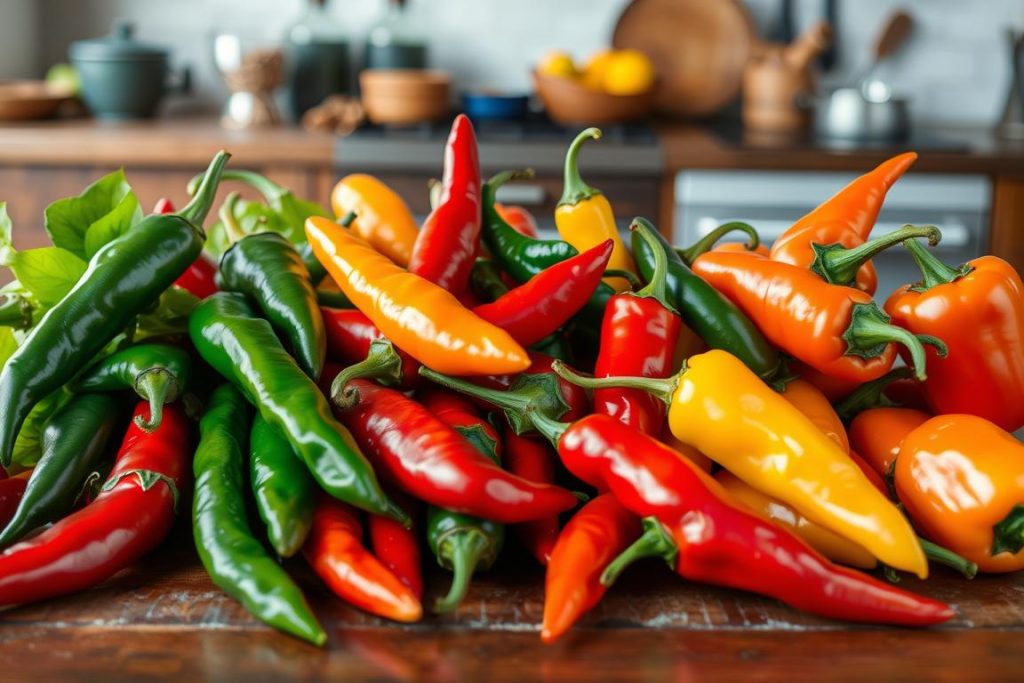
“The secret to enjoying spicy food is to let your taste buds slowly adjust to the heat, rather than trying to conquer it all at once.”
Best Cooking Methods for Different Chili Types
Choosing the right cooking method can really change how chili peppers taste and feel. Knowing the best ways to cook different types of chili can make your dishes better. It opens up a world of tasty options.
Roasting Techniques
Roasting chili peppers brings out their sweetness and smokiness. It’s great for bigger, thicker-skinned peppers like poblano, anaheim, and Hungarian wax. To roast, hold the peppers over an open flame or under a broiler, turning them until they’re charred.
Then, put the peppers in a sealed container to steam. Peel off the skin before using them in your recipe.
Incorporating into Sauces
Chili peppers add depth and spice to sauces, from chili con carne to sriracha. Think about the pepper’s heat level when adding it to sauce. Chop or blend the peppers to spread their flavor.
For a milder flavor, roast the peppers first. This can make the sauce less spicy.
Preservation Methods
There are ways to keep chili peppers fresh for longer. Drying makes the flavor stronger and keeps them longer. Pickling adds a tangy taste and keeps the peppers fresh. Freezing keeps the peppers’ taste and texture, but they might look different after thawing.
Exploring different cooking methods can lead to amazing chili dishes. Whether you roast, simmer, or pickle, the most important thing is to try new things. Find what works best for you and the chilies you have.
Understanding Chili Flavor Profiles Beyond Heat
Chili peppers are more than just hot. They bring a wide range of flavors that excite our taste buds. From sweet to smoky, they add depth and complexity to any dish.
Fruity peppers, like the Aji Amarillo from Peru, have a bright, tropical taste. They remind us of mango, papaya, or passion fruit. These peppers add a zesty kick to salsas, marinades, and even drinks.
Smoky chilies, such as chipotle and ancho, have a deep, earthy flavor. They are key in Mexican cooking, adding a rich taste to sauces and stews.
Earthy and herbaceous chilies, like guajillo and New Mexico, taste savory and slightly nutty. They are perfect for mole sauces and chili con carne, creating complex flavors.
| Chili Pepper Flavor | Example Varieties | Culinary Uses |
|---|---|---|
| Fruity | Aji Amarillo, Habanero, Scotch Bonnet | Salsas, marinades, cocktails |
| Smoky | Chipotle, Ancho, Pasilla | Sauces, stews, rubs |
| Earthy/Herbaceous | Guajillo, New Mexico, Ancho | Mole sauces, chili con carne |
Exploring chili pepper flavors opens up new possibilities in cooking. It allows us to create dishes with the right mix of heat and complexity.
“The true connoisseur of chilies appreciates them not just for their fiery kick, but for the profound depth of flavors they can impart.”
Regional Chili Cuisines for Beginners
Chili peppers are a big part of many cultures around the world. As you start to explore global chili dishes, it’s key to see how different places use them. From Mexico’s bold flavors to Asia and the Mediterranean’s spice mixes, each place has its own special way of using peppers.
Mexican Classics
Mexico loves chili peppers, and it shows in its famous dishes. Try mole, a sauce that adds depth to many foods. Or enjoy tacos al pastor with its spicy chipotle peppers. And don’t miss chiles en nogada, a dish that celebrates Mexico’s colors.
Asian Spice Traditions
In Asia, chili peppers are a big part of ethnic spicy cuisine. India’s curries use Bhut Jolokia and Kashmiri chili for their heat. Thailand’s stir-fries are known for their bird’s eye chili. Japan’s shishito pepper and togarashi spice blend are more subtle but just as interesting.
Mediterranean Uses
The Mediterranean also loves chili peppers, using them in global chili dishes. Try North Africa’s harissa paste, made with Aleppo pepper and caraway. Italy’s peperonata is a mix of roasted peppers, olive oil, and garlic.
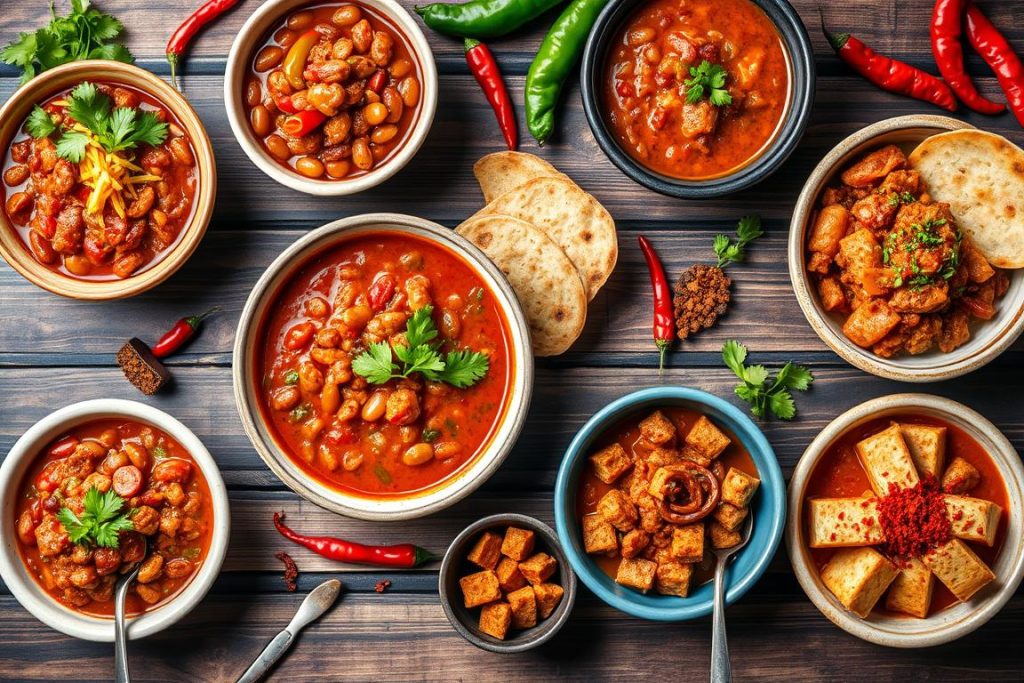
“Chili peppers are the heart and soul of many regional cuisines, each with their own unique flavors and cultural significance.”
Common Mistakes to Avoid When Starting with Chili
Starting your chili journey can be thrilling. But, it’s key to avoid common mistakes that can ruin your dish. As a beginner, knowing these mistakes can help you make delicious, balanced chili.
One big chili cooking error is not removing seeds and membranes properly. These parts are where most of the heat is. If you leave them in, your chili might be too spicy. So, it’s important to remove them to control the spice level.
Another mistake is not measuring dried chilies right. Dried chilies are much hotter than fresh ones. Using too much can make your chili too spicy. It’s best to follow recipes closely or start with small amounts to avoid pepper preparation mistakes.
- Properly remove seeds and membranes to control heat levels
- Measure dried chilies precisely to avoid overpowering spice
- Experiment with small batches to fine-tune the right balance of heat
By avoiding these common mistakes, you can start a tasty chili adventure. You’ll learn how to balance heat and flavors to make delicious chili.
Essential Tools and Equipment for Chili Preparation
Starting your chili-cooking journey? The right tools and equipment are key. They ensure your safety and make the prep process better. The right tools can also bring out the full flavor of your chili.
Kitchen Safety Gear
Working with chili peppers requires safety first. Wearing the right protective gear is crucial. Gloves protect your hands from capsaicin, and goggles shield your eyes from splashes or fumes.
Processing Tools
Preparing chili peppers involves different techniques. The right tools make these steps easier. A mortar and pestle or electric spice grinder are great for grinding dried peppers. For fresh peppers, a sharp knife and sturdy cutting board are must-haves.
Roasting or toasting chili peppers? A sheet pan or cast-iron skillet is perfect. They help even out the charring, enhancing the peppers’ flavor. Tongs or a spatula make handling hot peppers safe and easy.
With the right chili kitchen tools, pepper grinding equipment, and protective gloves, you’re ready to master chili prep. You’ll discover a world of flavors in your kitchen.
Growing Your Own Chili Peppers: Beginner’s Guide
Growing your own chili peppers is a fun and tasty journey. You can do it whether you have a big garden or a small balcony. Start by picking a chili type that fits your climate and skill level. Try the mild Anaheim or the bright Poblano.
It’s important to give your chili plants the right conditions for growth. They need full sun, good drainage, and steady water. Add organic stuff to the soil and use a balanced fertilizer for strong plants. Even with little space, you can grow chili peppers using the right container gardening methods.
As your chili plants grow, keep them trimmed and watch out for pests or diseases. With some patience and attention, you’ll get a delicious harvest. This guide is perfect for beginners who want to grow homegrown peppers or just try chili plant care.
